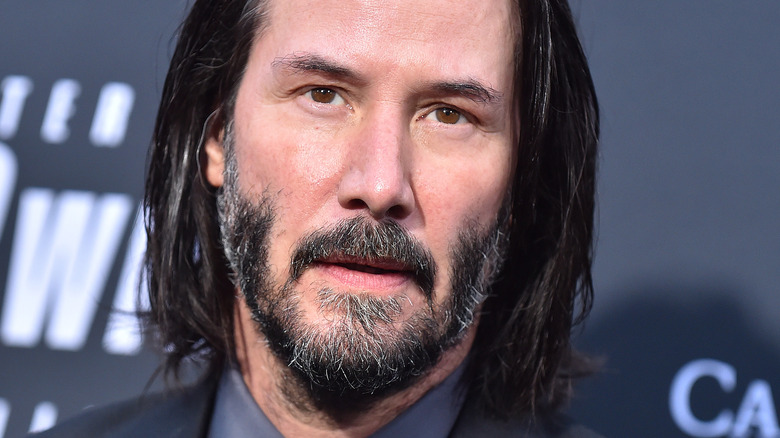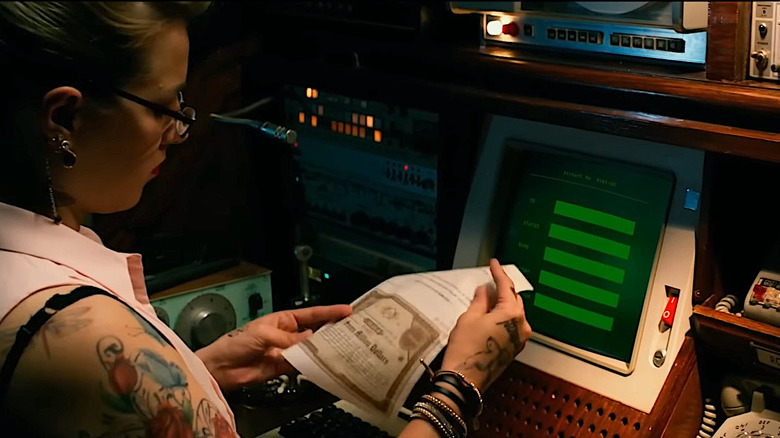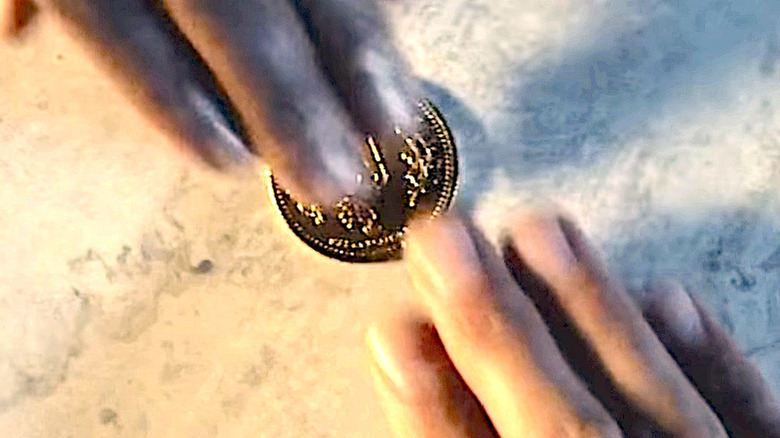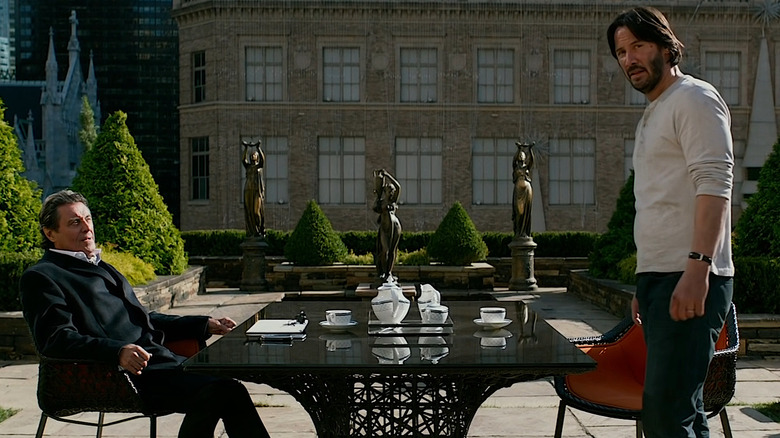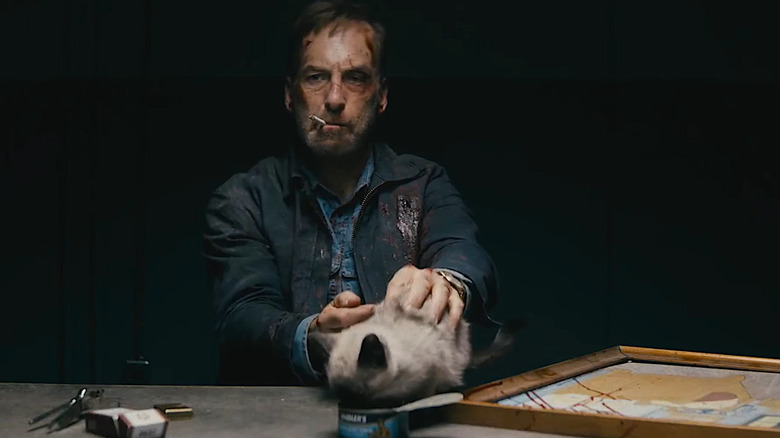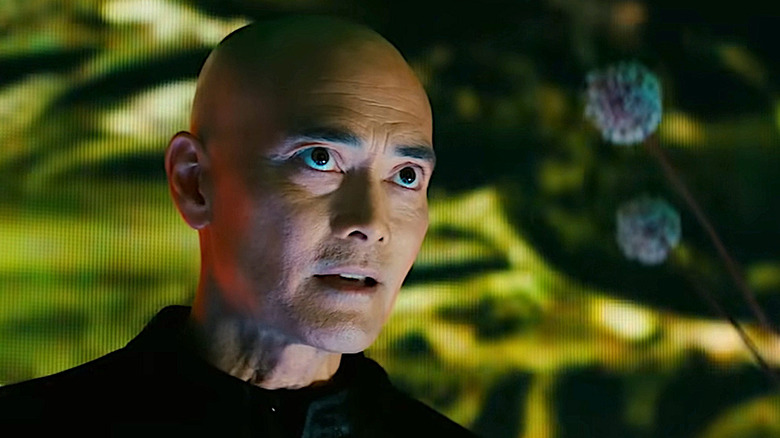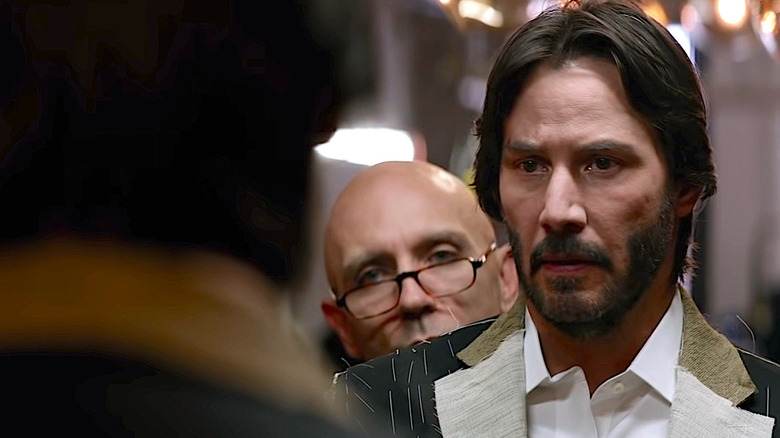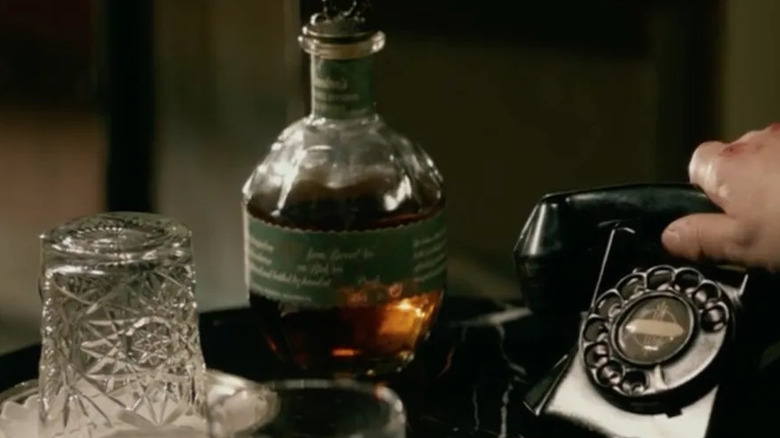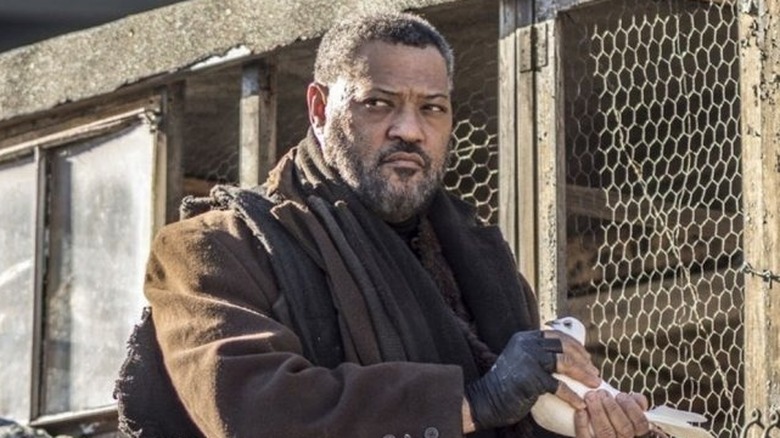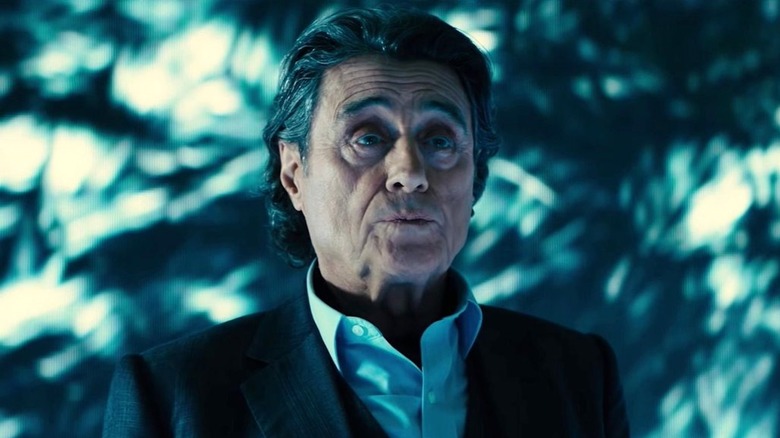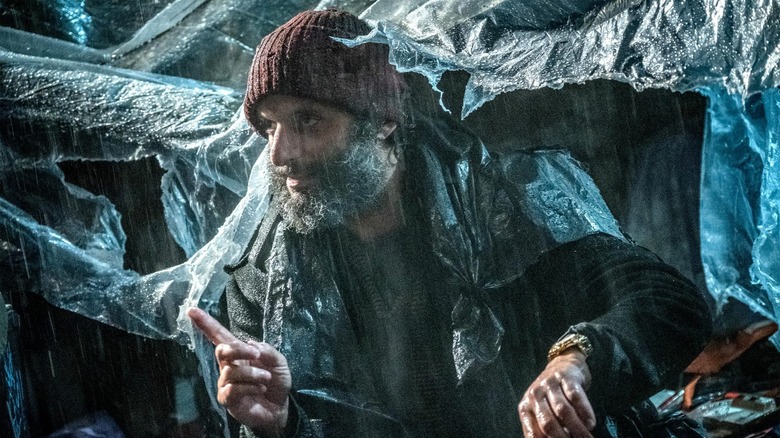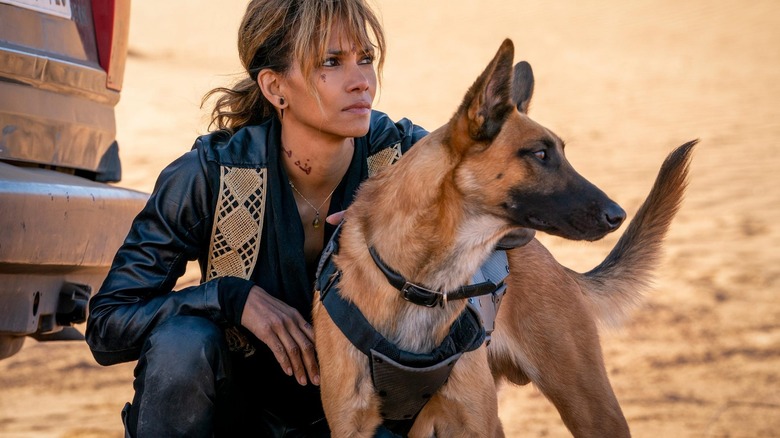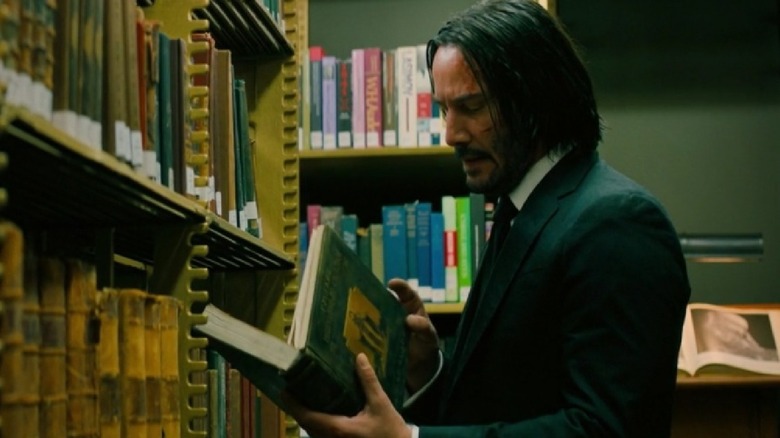Small Details You Might Have Missed In The John Wick Films
The "John Wick" franchise is a feast for fans' eyes as much as John Wick's pencil is a menace to those of his enemies. Starring Keanu Reeves at possibly his most powerful and poetic, the "John Wick" films kicked off both "The Keanussance" and the directorial careers of stunt superstars Chad Stahelski and David Leitch. The franchise has delivered three of five confirmed movies, a tie-in comic, and has promised at least one TV and movie spin-off so far. Heavy on style and action of substance, every entry in the "John Wick" franchise is a heart-pounding, show-stopping display of emotionally motivated, sumptuous spectacle — and also, there are awesome dogs.
These films are as beloved for their blink-and-you'll-miss-it world-building as much as they are for their brutal, balletic action. While Chad Stahelski hints at a longer runtime for "John Wick: Chapter 4," life in the John Wickiverse comes at you faster than a stolen Mustang during a round of car-fu. Luckily for you, we've slowed the tick-tock of time, sledgehammered through our basement floor, dug up some gold coins, and returned to a life we thought we left behind in order to provide some small details you might have missed in the "John Wick" films.
Analog operators are in, digital knives are out
John Wick has a superhuman ability to make himself and writing utensils into lethal weapons, but the love he has lost and the grief he's been denied make him deeply human. This broken-hearted balance is tricky to pull off, and just one example of the duality that drives many aspects of the "John Wick" franchise.
We get a great (but brief) glimpse of two opposite worlds working well together when Santino puts out a bounty on John Wick, and when Winston rules John "excommunicado" at the end of "John Wick: Chapter 2." These calls are fielded by sexy switchboard operators — contract killers working admin in pin-up pink shirts, sleeve tattoos, and painted nails — punching deadly details into 80s-era Commodore VIC-20 computers. These "accountants" also manually update John's bounty (and many others) on an old-school chalkboard of death. There's a method to this old-school madness — no assassin underworld worth its weight in gold coins wants their mainframe hacked.
Another killer example of two very different beasts working in harmony isn't even detectable by the naked eye. "John Wick: Chapter 3" opens with John fighting off a horde of would-be assassins in a hallway lined with glass cases full of knives. While the fighting is practical (per Variety), every knife (and piece of breaking glass) is digitally created. Every knife in the eye, axe to the head, and reflection tracked in glass is rendered "real" due to a magical, meticulously planned combination of excellence in practical performance and post-production visual effects artistry.
Coin-operated boy
From the style of his suits to his pre-grenaded mansion, John Wick has expensive tastes. In fact, the entire "John Wick" assassin network is a little rich for its own blood. In The Continental and the underworld beyond, a single, untraceable, specially-minted gold coin can cover the cost of cocktails — or a 12-body "cleaning" service. How much is one coin worth in the John Wick series? According to the U.S. Gold Bureau, it depends. While understanding the "John Wick" economy (via Forbes) might mess with your head, these coins represent a wildly fluctuating exchange rate — but also a gold standard payment in honor, secrecy, and respect. As Berrada (Jerome Flynn) says in "John Wick: Chapter 3," the coins represent "a social contract in which you agree to partake. Order and rules."
While seen up close only briefly, the coins are loaded with symbolism and Latin phrases. One side bears the image of a robed figure protected by a shield, and the phrase "Ex Unitae Veris" — "strength from unity." On the flip side stands a lion in front of a shield, and the phrase "Ens Causa Sui" — meaning "that which is generated by the self." Since the lion is vulnerable in front of the shield and the figure on the unity side is safe behind it, the gold coins seem like yet another glamorous reminder to the assassins spending them that honor among thieves is what separates those who serve The High Table from the animals — and that snitches get stitches.
The Continental is real and Green Goblin attacked it
A Four Seasons for assassins run by Ian McShane isn't exactly real — but you can still visit some of The Continental's glamorous grounds in real life. According to Atlas of Wonders, the exterior of The Continental's iconic corner entryway (and adjacent alley where John Wick is "killed" by Winston) is actually the Beaver Building, located at 1 Wall Street Court. The Cunard Building's majestic, nautical-themed lobby at 25 Broadway stands in for The Continental's grand entrance hall. Once the place to purchase tickets for the Cunard Steamship Line, this official New York City landmark's ornate vaulted ceilings and sea-inspired decor show that shipping magnates and stylish assassins share a taste for the finer things in life — especially Italian marble.
The Continental's rooftop is also (mostly) a real-life location, though you'll probably need an assist from your friendly neighborhood Spider-Man to visit the place. The Rockefeller Center roof gardens at 610 5th Avenue are generally closed to the public in real life, but they're where John meets with Winston after he refuses to honor Santino's blood oath marker in "John Wick: Chapter 2," and were recreated as a set for "Chapter 3." The view of St. Patrick's Cathedral might jog the memory of eagle-eyed viewers: Green Goblin, played by Willem Dafoe — who also appeared in the first "John Wick" — went after Peter Parker and Mary Jane here in Sam Raimi's "Spider-Man 2."
The Bob Odenkirk Atomic Blonde connection
A home invasion forces a former killer out of his quiet life and into a relentless quest for revenge — sound familiar? "Nobody" is a 2021 actioner written by Derek Kolstad, the screenwriter behind "John Wick," although the films don't share the same cinematic universe (or studio). Cut from the same stylish, psychotically secretive, super-violent cloth as the "John Wick" films, "Nobody" casts Odenkirk as Hutch Mansell, a powerful fixer gone dormant in his 50s, until an attack reawakens his true (and terrifying) nature. "Nobody" is packed with fully-felt action and world-building a la "John Wick" — and even has a cute animal in peril — while Odenkirk trained with stunt actor Daniel Bernhardt, who also appeared (via The AV Club) in "John Wick," "Nobody," and "Atomic Blonde."
"Atomic Blonde" is another beautiful, brutal action thriller with Wickian DNA — and a link to "Nobody." The film stars Charlize Theron (Reeves' "The Devil's Advocate" co-star) as a British secret agent hunting down traitors at the end of the Cold War. "Atomic Blonde" is directed by David Leitch, the (uncredited) co-director of the first "John Wick," and is also produced by Kelly McCormick, who also worked on that movie and produced "Nobody." While director Chad Stahelski can't predict the future of the "John Wick" franchise, a mega-crossover between "Nobody," "Atomic Blonde," and "John Wick" is (sadly) probably unlikely.
A culinary warrior almost cuts John down to size
Mark Dacascos appears in "John Wick: Chapter 3 — Parabellum" as John Wick's fanboy and would-be assassin, Zero — but the actor is no stranger to battle. An esteemed martial artist and action star, Mark Dacascos spent 20 years playing the Chairman on "Iron Chef" (via The Ringer), the intense overseer of wars waged in the legendary Kitchen Stadium. It's fitting that Zero is so good with a blade, seeing as Iron Chef America's logo is two clashing chef's knives. Zero may make his bones slicing and dicing those who have challenged The High Table, but his moonlighting as a sushi chef is also a likely nod to Dacascos' culinary campaigns.
While Dacascos is perfect casting for John's worthiest adversary so far, he was also a last-minute addition to the franchise. Hiroyuki Sanada tore his Achilles tendon before filming, and Dacascos – whose credits include "Hawaii Five-0," "Cradle 2 the Grave," and "Agents of S.H.I.E.L.D." — stepped up with lightning speed. He told Zavvi.com: "Chad texted me on Sunday, we talked on Monday, I was on a flight that night, shaved my hair on Wednesday and we started shooting on Thursday." No wonder this guy won the confidence of both The Adjudicator and Chad Stahelski. When it comes to "John Wick: Chapter 3," the secret ingredient to its success is clearly The Chairman himself.
John's suit is full of secrets
The "John Wick" script alluded to the character having the look of a Glock, which inspired Italian costume designer Luca Mosca to keep Reeves's suits for the film as sleek and powerful as possible. Mosca told Film Independent, "Even though a gun is dangerous and can be lethal, the Glock I looked at was charcoal gray, sleek and elegant in the way it caught the light. So that's how I made his gray suits: sleek and elegant."
Though John's suits look black to the naked eye, they're almost all entirely in shades of grey. This is partly to account for the film's painterly lighting schemes, and partly because Mosca wanted to convey a look of "perpetual mourning" for John. He told Gentleman's Journal that the only black suit John wears is in the Rome sequence in "John Wick: Chapter 2." Mosca also filled John's sleek suits with secret spaces for safety pads and small, flexible slices of fabric called gussets, which allowed the suit to go from bar fights to motorcycle sword duels seamlessly. As if Mosca wasn't busy enough making hundreds of copies of the same suit in various stages of destruction throughout the franchise, the designer even made a cameo in "Chapter 2" himself — fittingly, as John Wick's tailor.
Horse bourbon
For an action movie franchise where every frame is laced with myth and maximalism, the characters of "John Wick" drink real-world — and sometimes really rare — liquor. John Wick's personal poison appears to be bourbon. But which brand? According to Liquor Laboratory, John drinks Blanton's, known to those in secret underworld circles as "the really hard to find bourbon that comes with a cool horse figurine stopper." John drinks Blanton's single-barrel bourbon to nurse his wounds as he's stitched up in "John Wick," and sips their special reserve Green Label in "Chapter Two." While the supply chain and a bunch of thirsty fans have made Blanton's occasionally hard to find, there's an even more rare bourbon out there. According to a press release, Continental Bourbon was introduced in 2019 as a tie-in to "Chapter 3," but alleged quality control issues led to the product being canceled (via Facebook).
Not to worry, there's plenty more to imbibe in the real world and world of "John Wick," including Peligroso Tequila, Glenlivet 18 year scotch, and Orange Fanta. John pours a shot of Jewel of Russia Ultra Vodka for Abram Tarasaov (Peter Stormare) after killing his brother, Viggo. Abram accepts this peace offering, showing that while he has his own mob chop shop, he also has horse sense. Stormare has worked opposite Reeves many times before, most notably as the devil in "Constantine," a film that sees Reeves trade bourbon for scotch – Ardberg 10, to be exact.
The Matrix made John Wick
It's poetic that the most genre-transforming action franchise of the '90s and 2000s would give rise to the most genre-transforming action franchise of today. "The Matrix" first connected Keanu Reeves and future "John Wick" directors Chad Stahelski and David Leitch. Both were stuntmen on the Wachowski sisters' groundbreaking sci-fi epics, while Stahelski was Neo's stunt double (via Vulture) and the films' stunt coordinator. The friendships forged on the "Matrix" trilogy would ultimately bear ultra-violent fruit in the form of "John Wick."
Laurence Fishburne's calm yet challenging Morpheus mentored Reeves' naive but nimble Neo in "The Matrix," and echoes of this relationship appear in the "John Wick" franchise, with Reeves and Fishburne again unlikely allies some 18 years later. Fishburne plays The Bowery King, the leader of the underworld's underworld, an intelligence association masquerading as The Soup Kitchen. Of course, there are Easter eggs and quotes alluding to "The Matrix" in the "John Wick" films, but more than that, the franchises have a shared action ethos. Stahelski told Esquire, "For most of how I made 'John Wick,' and most of how I direct, it's pure Wachowskis — their attention to detail." Stahelski got to return some of the Wachowski creative favor with his "meta-cameo" in "The Matrix: Resurrections."
There's a celebrity gun cameo
With each new entry in the "John Wick" series, its lethal and luxurious world expands. We get longer looks at the little details that make the world symbolic and stylish, as we learn more about The High Table, The High Kids' Table (RIP Santino), and those who prefer to lounge at one of The Continental's classy tables. Set decorator David Schlesinger spoke to Set Decor about said expansion in "John Wick: Chapter 3 — Parabellum," particularly when it came to building upon Winston's personal space.
Impeccably stylish, Winston is rarely without a cravat or his signature dry wit. He runs The Continental, its impressive armory, and even more impressive (yet so far unseen) 10,000-bottle wine cellar. The man has a lot on his plate, and maybe not enough in his glass. Schlesinger told Set Decor that the armory quickly transitioned into a private space for Winston, and was decorated as such. Built on a stage, Winston's armory is comprised of tastefully appointed vintage lights, printed flooring, and a wall of real guns — including a small gun in the center: a replica of Abraham Lincoln's murder weapon. Schlesinger insisted, however, that "[John Wilkes] Booth was not a member of The Continental!"
A beloved comedian plays the Tick Tock Man
You may recognize comedian Jason Mantzoukas from his work as Scrabble-letter swilling Derek on "The Good Place," deranged maniac Rafi on "The League," or chill (and blood-chilling) 'The Grandfather' on "Paper Girls." But were you aware that sweetly scratchy voice informing us all that "America runs on Dunkin" and "How Did This Get Made" also belongs to "John Wick: Chapter 3's" Tick Tock Man?
Buds with (or serf of) Laurence Fishburne's Bowery King, Mantzoukas' Tick Tock Man spends his screen time sassing John Wick on the street — when he isn't literally carting him to the Bowery King's lair. Jason Mantzoukas shared an exclusive scoop about "John Wick 4 & 5" with Conan O'Brien, joking that both feature his and Reeves' character getting into "hi-jinks." "Would you be surprised to hear that we go on a double date in the movie that doesn't go well? Because he's got his dog that's with him all the time, they're giving me an animal, I'm getting a parrot, I'm pretty excited about it. Spoilers for 'John Wick 4', I kill John Wick, and then the next movie is just 'Tick Tock Man Chronicles.' 'John Wick: Chapter 5 — Tick Tock Man Chronicles.'"
Dog Fu was created for the film
A benefit of having one of Hollywood's most prolific stuntmen at the helm of an action franchise is that he's not going to be afraid to develop martial arts for dogs. "John Wick" director Chad Stahelski worked with Halle Berry and a team of dog trainers to teach a fleet of Belgian Malinois the art of "dog fu" for "John Wick: Chapter 3." The form they developed helped the canine actors play aggressively, rather than attack on command and engage in actual fight responses.
Berry plays Sofia in the film, proprietor of Morocco's Continental counterpart. Keanu Reeves told Entertainment Weekly, "Halle spent over eight months, on and off, working with the trainers, to a point where, when I was training with her, the trainer said to me, 'They treat her like a trainer.'" Berry grew close to the five dogs she trained with, even calling one of them her "work husband" on an Instagram post. While Berry confirmed to Variety that her character wouldn't appear in "John Wick: Chapter 4," she insinuated that her relationship with the franchise wasn't over, with a possible spin-off movie in the works. We, for one, can't wait for more Halle Berry in action, in the potential "Who Let The Dogs Out: A John Wick Mystery."
John Wick's writer might have mixed up his Russian folklore
"They call him Baba Yaga." "The Bogeyman?" "Well, John wasn't exactly the Bogeyman. He was the one you sent to kill the Bogeyman." So goes the now-classic exchange between Viggo and Iosef Tarasov in "John Wick" about John's scary nickname. But according to Russia Beyond, "John Wick" fumbled the use of "Baba Yaga" as a frightening code name for the assassin. John Wick's nickname is actually a mix of two different Russian legends — with similar spellings.
Baba Yaga is the name of a witch who is sometimes helpful, sometimes cannibalistic to children, and who lives in a house with chicken legs. "Babayka" is the Russian mythological equivalent of the bogeyman, who steals naughty children during the night. While we would rather not encounter either of these creatures while out traipsing through the Eastern European woods, it's funny that the richly detailed world of "John Wick" missed a trick on this one.
While the nickname may not make "logical sense," like the currency in circulation at The Continental, it still strikes a nice aesthetic nerve — much like the book John Wick uses to beat down an attacker in the New York Public Library. According to that institution, the tome in John's hands is "Russian Folk Tale" by Aleksandr Afanasyev, which he says was published in 1864. The only problem is that Afanasyev didn't publish any collections of folk tales in 1864. Another assassin Easter egg, or an honest folklore mistake? We'll let you be the judge.
